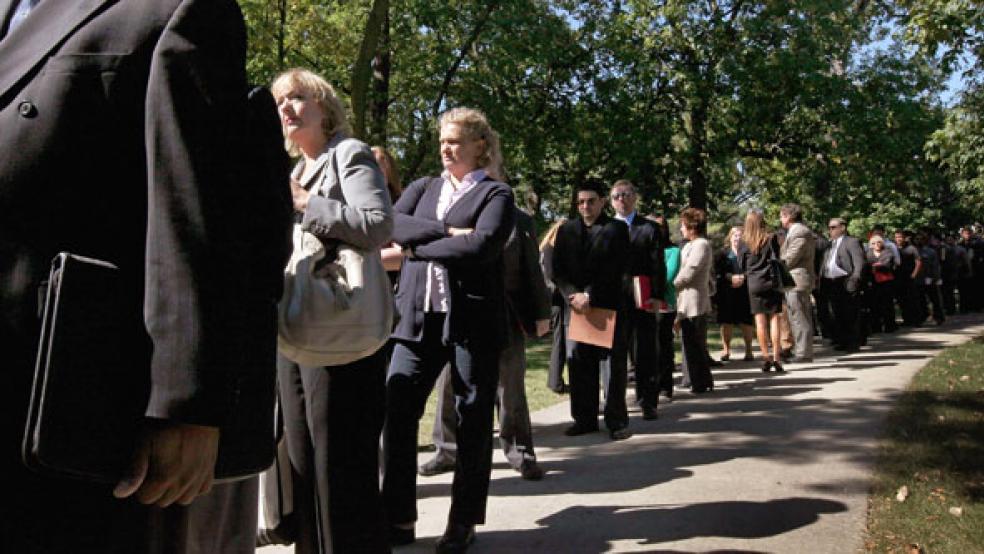Standing conventional stock market wisdom on its head, investors may wish for weaker-than-expected employment numbers next Friday.

A strong jobs report could prompt an early end to the Federal Reserve's policy of pumping money into the banking system to rescue the economy and set off the stock market's long-awaited pullback. The Fed's loose monetary policy since the end of 2008 has kept interest rates low and propelled stocks to record highs.
RELATED: Edgy About Interest Rates? Don't Pop the Xanax Yet
Last week, stocks fell and bond yields surged after Fed Chairman Ben Bernanke said the U.S. central bank may decide to taper its stimulus programs in the next few policy meetings if data shows the economy is gaining traction. Stocks posted their second straight week of losses on Friday, mostly on fears that the Fed would curb its bond-buying program sooner than most people expected.
"We're in a mindset where the market seems to be very fearful of the Fed beginning a tapering," said Quincy Krosby, market strategist at Prudential Financial in Newark, N.J. "Those in the market based on easy money ... will probably exit" if the May jobs number exceeds expectations, she said.
The market has managed to climb this year without any substantial pullback. Concerns about the Fed's next move have increased speculation that a major bout of selling is ahead. A stronger-than-expected jobs number "would continue to produce the concerns you've seen manifested in the market over the last couple of days," said Mark Luschini, chief investment strategist at Janney Montgomery Scott in Philadelphia, which manages about $58 billion in assets.
RELATED: 4 Economic Predictions Prove Doomsayers Are Wrong
Economists say job gains of at least 200,000 per month over several months are needed to significantly reduce high unemployment. The Fed has said it will keep interest rates at historic lows until the U.S. unemployment rate drops to 6.5 percent.
Employers are expected to have added 168,000 jobs to their payrolls in May, according to economists polled by Reuters. That's slightly above April's count of 165,000 new positions. The U.S. unemployment rate is expected to hold steady at 7.5 percent in May.
To be sure, better-than-expected jobs data would be evidence of strength in the economy, a positive for the market in the long run, so any pullback could be short-lived, analysts said. "If it's a short-term correction, I think that would have to be opportunistic, in the sense that investors should take advantage of moving any sideline money into the equity market," Luschini said. Even with the recent losses - the Standard & Poor's 500 index .SPX fell 1.1 percent this week - the index rose 14.34 percent for the first five months of 2013. That gain marked the S&P 500's best first five months of any year since 1997.
DITCHING DIVIDEND STOCKS
A rotation out of high-yielding dividend stocks has already begun because of the rise in U.S. Treasury bond yields. Dividend stocks had been among the market's leaders for much of this year's rally as investors favored those shares over fixed-income securities in a low interest-rate environment. "The first crack we've seen is, as bond yields have been going up, people are moving out of that area," said Eric Kuby, chief investment officer of North Star Investment Management Corp., in Chicago.
"Managers are starting to look at things other than consumer staples with nice dividends and stable businesses. So within the stock market, you're seeing more volatility within sectors." The S&P 500 gained 2.1 percent for the month of May, while the S&P utilities sector index .SPLRCU lost 9.6 percent and the S&P consumer staples index .SPLRCS dropped 2.4 percent.
The spread between the S&P 500 dividend yield and the 10-year U.S. Treasury note's yield this week hit its narrowest in about a year. The S&P 500 dividend yield was at 2.39 percent, while the 10-year note's yield hit 2.235 percent during the week. By comparison, the dividend yield on the utilities sector stands at about 4 percent.
The move out of dividend-paying and other defensive shares should continue as the economy improves, Kuby said, though he pointed out that the market is still a "long way" from seeing high interest rates. "The fact that rates are likely to creep up over time, that's a given. And it's not going to be sudden or dramatic. It's going to be more gradual."
IT'S RAINING NUMBERS
Next week will bring a snapshot of U.S. manufacturing activity from the Institute for Supply Management, which releases its May index on Monday. Economists polled by Reuters expect a reading of 50.5 for May, compared with 50.7 in April. Monday's economic agenda also calls for April construction spending - forecast up 0.8 percent after a drop of 1.7 percent in March.
Domestic car and truck sales for May, also expected on Monday, are projected to have increased to 15.1 million units from April sales of about 14.9 million units, the Reuters Poll showed.
The U.S. international trade deficit, set for release Tuesday, is forecast to have widened slightly to $41 billion in April from $38.8 billion in March.
A preview of the jobs picture will come on Wednesday with the release of a report from payrolls processor ADP. Economists polled by Reuters have forecast that the ADP data will show private-sector employers added 165,000 jobs in May, compared with 119,000 in April.
This article is by Caroline Valetkevitch of Reuters.




